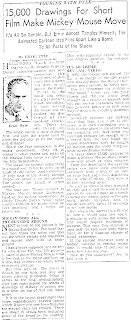But his byline was familiar before that. Pyle had a distinctive daily column for the Scripps-Howard news service through most of the ‘30s. He covered whatever struck his fancy. And, one day, he decided to cover the making of animated cartoons.
This story is from 1938. What’s notable, besides Pyle’s “guess what I learned” writing style, is it’s not a puff piece for Walt Disney. There are no pontifications from Disney himself, no plugging of movies with dwarves. Pyle sticks to revealing to his readers the basic process of animation.
And I like the irony how Pyle has no qualms about using the word “hell” in print, something no Disney character would ever say on screen.
15,000 Drawings For Short Film Make Mickey Mouse Move
It’s All So Simple, But Ernie Almost Tangles Himself; The Animated-Cartoon Idea Flies Apart Like a Bomb To All Parts of the Studio
By ERNIE PYLE
Scripps-Howard Roving Reporter
HOLLYWOOD, March 3.—After they’ve finally decided to put a Disney animated-cartoon idea into production, the thing sort of flies apart like a bomb and goes to all parts of the studio.
First to the music and voice departments which immediately start writing the music and recording the dialogue of the speaking characters. That’s an odd thing, too.
The whole movie is done in sound first, and then the artists have to draw the pictures to fit the music and dialogue.
There are four composers in the music department. They sit at pianos in small rooms and make up the fanciful little times we hear in the Silly Symphonies.
The sound (or casting) department is a weird one. It has to think up all kinds of silly noises. And incidentally only four of the Disney cartoon voices are actually on the payroll. The others are called in when needed.
The four are: Disney himself, as Mickey Mouse; Stuart Buchanan, head of the casting department, as Goofy; Donald Duck’s “voice” takes visitors through the studio when he isn’t quacking; and I forget the fourth one.
 MICKEY DOES ALL THE RUNNING AROUND
MICKEY DOES ALL THE RUNNING AROUNDNEXT to leap on the picture is the layout department. The head layout man takes the script and lays out the whole picture into sequences and scenes, each with its background. I had always supposed that an artist who drew the, say 150 pictures it takes to make Mickey Mouse walk a few feet in the forest and look up a tree, had to draw the whole forest into every picture.
But that isn’t so. The forest is drawn by one man, and only one forest drawing is needed. When it comes to the final photographing, they just superimpose the scores of drawings of Mickey in action, one at a time, on top of that one forest scene.
It is in the layout department that those magnificently colored scenes which Disney pictures have featured for several years are created. There are about 25 artists here, including some of the finest in the country. Men who regularly exhibit in the Los Angeles galleries, for instance.
IT’S SO SIMPLE BUT—AW, NERTS!
LAST, the director gets started. He is in charge of the 250 artists who actually make; the Disney characters move around. So here’s how:
You all remember the children’s “flip books,” where you take your thumb and flip the whole book through in a couple of seconds, and you can see the characters move as you go along, because on each page they’ve drawn in a slightly different position.
Animated cartoons are nothing more than that. Just a lot of pictures, with each succeeding one a little further along in the action than the preceding one, And when you run them through fast enough, as in a movie film, the tiny lapses between movements can’t be caught by the eye, and the whole thing appears as continuous motion.
It takes about 15,000 pictures to make a Mickey Mouse short, which runs only seven or eight minutes.
From one drawing to the next the artists can move their characters anywhere from a 64th of an inch up to an inch and a half, depending on the type of action. This scale is on their drawing paper.
In a series where Mickey is moved an inch and a half forward in each picture, he would simply be a streak crossing the screen, going so fast you could barely recognize him. It would take only about 10 drawings to get him across.
But where the interval is a 64th of an inch it would lake him nearly a minute to walk across the screen, and would require hundreds of pictures. This very fine interval is used only for very slow body movement, or for a close-up change of facial expression.
If the cartoon character were a soldier, walking in regular march time, it would take 12 pictures to make him take one step.
Now do you understand? Aw, to hell with it.

No matter how many times I've read about it, I'm always a sucker for these "how cartoons are made" articles.
ReplyDelete(any idea who the fourth voice actor is?)
Love seeing "Aw Nerts!" in a sentence!
ReplyDeleteMy guess would be Marcellite Garner. Wasn't she still in ink & paint at Disney the time this was written?
ReplyDeleteA little over 20 years later, a Disney character (Maleficent) DID say "Hell" on screen.
ReplyDelete